The 41st Annual IEEE/ACM International Symposium on Microarchitecture, 2008 |
About Como
Historical Overview
The hills surrounding the current location of Como have been inhabited since at least the Bronze Age, by a Celtic tribe known as the Orobii. Remains of settlements are still present on the wood covered hills to the South West of town. Around the 1st Century BC, the territory became subject to the Romans. The urban center (Comum Oppidum) was situated on the nearby hills, but was moved to its current location by order of Julius Caesar, who had the swamp near the southern tip of the lake drained and laid the plan of the walled city in the typical Roman grid of perpendicular streets. The new town was named Novum Comum and had the status of municipium.
In 774, the town surrendered to invading Franks led by Charlemagne, and became a center of commercial exchange. In 1127, Como lost a decade-long war with the nearby town of Milan. A few decades later, with the help of Frederick Barbarossa, the Comaschi could avenge their defeat when Milan was destroyed in 1162. Frederick promoted the construction of several defensive towers around the city limits. From the XV century, Como became part of the Duchy of Milan, at first under the Visconti and Sforza dukes, then under Spanish and Austrian domination.
In 1859, with the arrival of Giuseppe Garibaldi, the town was freed from the Austrians and became part of the newly formed Kingdom of Italy under the House of Savoy. At the end of World War II, after passing through Como on his escape towards Switzerland, Mussolini was taken prisoner and then shot by partisans in Giulino di Mezzegra, a small town on the north shores of Como Lake.
What to see in Como
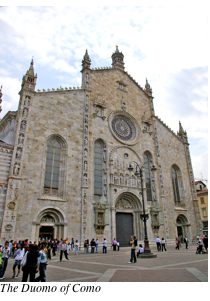 The Duomo (cathedral), begun in 1396 on the site of the previous Romanesque church of Santa Maria Maggiore. The façade was built in 1457, with the characteristic rose window and a portal flanked by two Renaissance statues of the famous Comaschi Pliny the Elder and Pliny the Younger. The construction was finished in 1740. The interior is on the Latin cross plan, with Gothic nave and two aisles divided by pilasters, while the transept wing and the relative apses are from the Renaissance age. It includes a carved 16th century choir and tapestries on cartoons by Giuseppe Arcimboldi. The dome is a rococo structure by Filippo Juvarra. Other artworks include 16th-17th Century tapestries and 16th Century paintings by Bernardino Luini and Gaudenzio Ferrari.
The Duomo (cathedral), begun in 1396 on the site of the previous Romanesque church of Santa Maria Maggiore. The façade was built in 1457, with the characteristic rose window and a portal flanked by two Renaissance statues of the famous Comaschi Pliny the Elder and Pliny the Younger. The construction was finished in 1740. The interior is on the Latin cross plan, with Gothic nave and two aisles divided by pilasters, while the transept wing and the relative apses are from the Renaissance age. It includes a carved 16th century choir and tapestries on cartoons by Giuseppe Arcimboldi. The dome is a rococo structure by Filippo Juvarra. Other artworks include 16th-17th Century tapestries and 16th Century paintings by Bernardino Luini and Gaudenzio Ferrari. 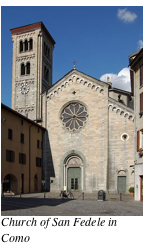
San Fedele, a Romanesque church erected around 1120 over a pre-existing central plan edifice. The orginial bell tower was rebuilt in modern times. The main feature is the famous Door of St. Fedele, carved with medieval decorations. Sant'Agostino, built by the Cistercians in the early 14th Century, heavily renovated in the 20th. The interior and adjoining cloister have 15th-17th Century frescoes, but most of the decoration is Baroque.
The Romanesque basilica of Sant'Abbondio, consecrated in 1095 by Pope Urban II. 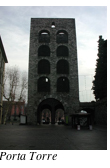 The interior, with a nave and four aisles, contains paintings dating to the 11th Century and frescoes from the 14th. San Carpoforo (11th Century, apse and crypt from 12th Century). According to tradition, it was founded re-using a former temple of the God Mercury to house the remains of St. Carpophorus and other local martyrs.
The interior, with a nave and four aisles, contains paintings dating to the 11th Century and frescoes from the 14th. San Carpoforo (11th Century, apse and crypt from 12th Century). According to tradition, it was founded re-using a former temple of the God Mercury to house the remains of St. Carpophorus and other local martyrs.
Among the medieval public buildings can be found the Broletto, the ancient town hall dating back to 1215, and the Porta Torre, the only surviving part of the city wallsbuilt by emperor Barbarossa in 1158 (the original city walls had been destroyed thirty years before by the troops of Milan).
What to see outside the city
The lake is well-known for the attractive villas which have been built here since Pliny the Younger constructed the Comedia and the Tragedia. Many have admirable gardens which benefit from the mild climate induced by the stabilising presence of 22.5 km³ of lake water and are able to include tropical as well as temperate plants.
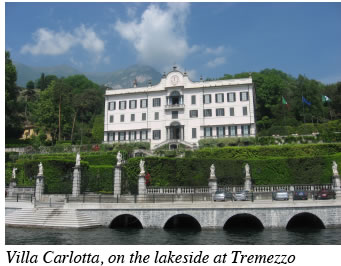 The Villa Carlotta was built for the Milanese marchese Giorgio Clerici in 1690 and occupies a site of over 70,000 m² at Tremezzo, facing the Bellagio peninsula. An Italian garden, with steps, fountains and sculpture was laid out at the same time. The villa was later sold to the banker and Napoleonic politician Giambattista Sommariva. Stendhal was his guest in 1818, and his visit is recalled at the start of La Chartreuse de Parme. In 1843 it was purchased by Princess Marianne of Nassau as a wedding present for her daughter Carlotta, after whom the villa is now named. The latter, together with her husband, Georg II of Saxen-Meiningen laid out the wooded park in the Romantic style. The villa today includes a museum of agricultural implements as well as important works of sculpture by Sommariva’s friend Antonio Canova and by Luigi Acquisti.
The Villa Carlotta was built for the Milanese marchese Giorgio Clerici in 1690 and occupies a site of over 70,000 m² at Tremezzo, facing the Bellagio peninsula. An Italian garden, with steps, fountains and sculpture was laid out at the same time. The villa was later sold to the banker and Napoleonic politician Giambattista Sommariva. Stendhal was his guest in 1818, and his visit is recalled at the start of La Chartreuse de Parme. In 1843 it was purchased by Princess Marianne of Nassau as a wedding present for her daughter Carlotta, after whom the villa is now named. The latter, together with her husband, Georg II of Saxen-Meiningen laid out the wooded park in the Romantic style. The villa today includes a museum of agricultural implements as well as important works of sculpture by Sommariva’s friend Antonio Canova and by Luigi Acquisti.
The Villa d'Este, at Cernobbio, was built in 1568 by Cardinal Tolomeo Gallio, a native of the town. In 1816–17 the villa was home to Caroline of Brunswick, estranged wife of the Prince of Wales and shortly to become Queen Consort of King George IV of the United Kingdom. The landscaped gardens in the English style are a product of this period. Later in the century it was turned into a luxury hotel. Today the Villa d’Este is known for attracting celebrity guests.
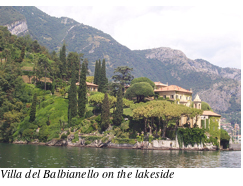 The Villa del Balbianello, famous for its elaborate terraced gardens, lies on a promontory of the western shore of the lake near Isola Comacina. Built in 1787 on the site of a Franciscan monastery, it was the final home of the explorer Guido Monzino and today houses a museum devoted to his work.
The Villa del Balbianello, famous for its elaborate terraced gardens, lies on a promontory of the western shore of the lake near Isola Comacina. Built in 1787 on the site of a Franciscan monastery, it was the final home of the explorer Guido Monzino and today houses a museum devoted to his work.
The Villa Melzi, at Bellagio was built in the neo-classical style by the architect Giocondo Albertolli in 1808–10 as the summer residence of Francesco Melzi who had been vice-president of the Napoleonic Italian Republic. The park includes an orangery, a chapel, statues and a Japanese garden, and is planted, as often on lake Como, with huge rhododendrons. Nineteenth-century guests at the Villa included Stendhal and Franz Liszt.
The Villa Serbelloni, also at Bellagio, houses the Bellagio Study and Conference Center, a residential center set up and managed by the Rockefeller Foundation since 1959, which operates a 'scholar-in-residence' program for scholars from around the world. This is believed to have been the site of Pliny the Younger’s villa ‘Tragedia’. Its well-known park was created at the end of the eighteenth century by Alessandro Serbelloni.
Links
Lake Como [Wikipedia]
Como town [Wikipedia]
Website of the Como municipality
Como Tourism Office
 The Duomo (cathedral), begun in 1396 on the site of the previous Romanesque church of Santa Maria Maggiore. The façade was built in 1457, with the characteristic rose window and a portal flanked by two Renaissance statues of the famous Comaschi Pliny the Elder and Pliny the Younger. The construction was finished in 1740. The interior is on the Latin cross plan, with Gothic nave and two aisles divided by pilasters, while the transept wing and the relative apses are from the Renaissance age. It includes a carved 16th century choir and tapestries on cartoons by Giuseppe Arcimboldi. The dome is a rococo structure by Filippo Juvarra. Other artworks include 16th-17th Century tapestries and 16th Century paintings by Bernardino Luini and Gaudenzio Ferrari.
The Duomo (cathedral), begun in 1396 on the site of the previous Romanesque church of Santa Maria Maggiore. The façade was built in 1457, with the characteristic rose window and a portal flanked by two Renaissance statues of the famous Comaschi Pliny the Elder and Pliny the Younger. The construction was finished in 1740. The interior is on the Latin cross plan, with Gothic nave and two aisles divided by pilasters, while the transept wing and the relative apses are from the Renaissance age. It includes a carved 16th century choir and tapestries on cartoons by Giuseppe Arcimboldi. The dome is a rococo structure by Filippo Juvarra. Other artworks include 16th-17th Century tapestries and 16th Century paintings by Bernardino Luini and Gaudenzio Ferrari. 
 The interior, with a nave and four aisles, contains paintings dating to the 11th Century and frescoes from the 14th. San Carpoforo (11th Century, apse and crypt from 12th Century). According to tradition, it was founded re-using a former temple of the God Mercury to house the remains of St. Carpophorus and other local martyrs.
The interior, with a nave and four aisles, contains paintings dating to the 11th Century and frescoes from the 14th. San Carpoforo (11th Century, apse and crypt from 12th Century). According to tradition, it was founded re-using a former temple of the God Mercury to house the remains of St. Carpophorus and other local martyrs. The Villa Carlotta was built for the Milanese marchese Giorgio Clerici in 1690 and occupies a site of over 70,000 m² at Tremezzo, facing the Bellagio peninsula. An Italian garden, with steps, fountains and sculpture was laid out at the same time. The villa was later sold to the banker and Napoleonic politician Giambattista Sommariva. Stendhal was his guest in 1818, and his visit is recalled at the start of La Chartreuse de Parme. In 1843 it was purchased by Princess Marianne of Nassau as a wedding present for her daughter Carlotta, after whom the villa is now named. The latter, together with her husband, Georg II of Saxen-Meiningen laid out the wooded park in the Romantic style. The villa today includes a museum of agricultural implements as well as important works of sculpture by Sommariva’s friend Antonio Canova and by Luigi Acquisti.
The Villa Carlotta was built for the Milanese marchese Giorgio Clerici in 1690 and occupies a site of over 70,000 m² at Tremezzo, facing the Bellagio peninsula. An Italian garden, with steps, fountains and sculpture was laid out at the same time. The villa was later sold to the banker and Napoleonic politician Giambattista Sommariva. Stendhal was his guest in 1818, and his visit is recalled at the start of La Chartreuse de Parme. In 1843 it was purchased by Princess Marianne of Nassau as a wedding present for her daughter Carlotta, after whom the villa is now named. The latter, together with her husband, Georg II of Saxen-Meiningen laid out the wooded park in the Romantic style. The villa today includes a museum of agricultural implements as well as important works of sculpture by Sommariva’s friend Antonio Canova and by Luigi Acquisti.  The Villa del Balbianello, famous for its elaborate terraced gardens, lies on a promontory of the western shore of the lake near Isola Comacina. Built in 1787 on the site of a Franciscan monastery, it was the final home of the explorer Guido Monzino and today houses a museum devoted to his work.
The Villa del Balbianello, famous for its elaborate terraced gardens, lies on a promontory of the western shore of the lake near Isola Comacina. Built in 1787 on the site of a Franciscan monastery, it was the final home of the explorer Guido Monzino and today houses a museum devoted to his work.